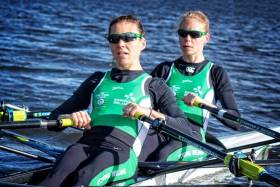Displaying items by tag: seaman
Jennings and Lambe Win C Final at World Cup in Varese
#Rowing: Sinéad Jennings and Claire Lambe ended their campaign at the World Cup Regatta in Varese with a commanding performance to win the C Final of the lightweight double sculls. They led all the way and were four lengths clear of nearest rivals, Italy Three, at the finish.
Ireland had two competitors in the repechage of the women’s lightweight single sculls. There were two places on offer in an A Final, but Poland and Switzerland One took these. Siobhán McCrohan finished fifth and Denise Walsh sixth. In the lightweight men’s four, Ireland battled it out for third in the C Final with Austria, losing out by .15 of a second. In the C Final of the women’s pair, Leonora Kennedy and Barbara O’Brien finished third. Norway pipped Ukraine to win.
World Cup Regatta, Varese – Day Two (Selected Results, Irish interest)
Men
Lightweight Four – C Final (places 13 to 16): 1 Canada One 6:09.73, 2 Serbia 6:11.21, 3 Austria 6:15.85, 4 Ireland (L Seaman, M O’Donovan, L Keane, S O’Driscoll) 6:16.00.
Women
Pair – C Final (places 13 to 16): 1 Norway One 7:22.74, 2 Ukraine 7:23.16, 3 Ireland (L Kennedy, B O’Brien) 7:33.07.
Lightweight Double Sculls – C Final (places 13 to 17): 1 Ireland (C Lambe, S Jennings) 7:17.24, 2 Italy Three 7:26.29, 3 Chile 7:29.71.
Lightweight Single Sculls – Repechage (First Two to A Final; rest to B Final): 1 Poland Two 7:49.90, 2 Switzerland One 7:51.76; 5 Ireland Two (S McCrohan) 8:04.69, 6 Ireland One (D Walsh) 8:08.81
Probe into Death of Seaman at Waterford Port
An investigation has been launched into the death of a seaman in Waterford Port yesterday.
The Irish Independent reports that the 51-year-old sailor from the Philippines fell more than five metres after being struck by machinery.
He had been tying down a load on the cargo ship MV Scot Pioneer when the incident occurred around lunchtime yesterday. He later died from his injuries.
The Health and Safety Authority and gardaí went to the scene, and RTÉ News reports that a post-mortem was set to take place yesterday afternoon.
The Port of Waterford Company also issued a statement extending its sympathies to the man's family and colleagues.

























































